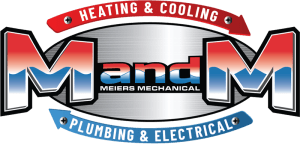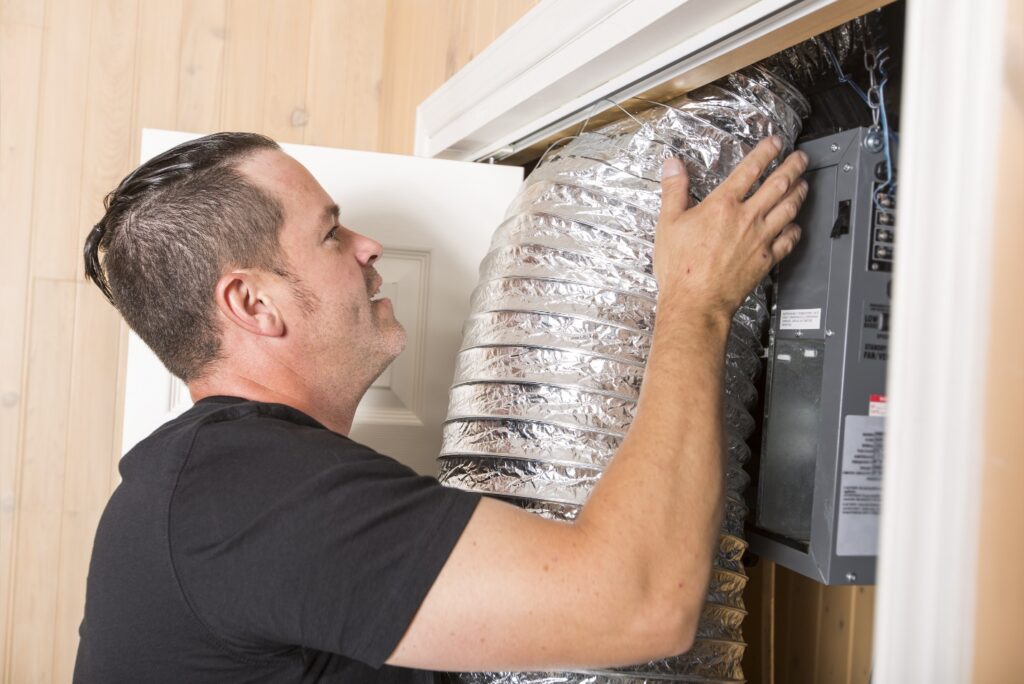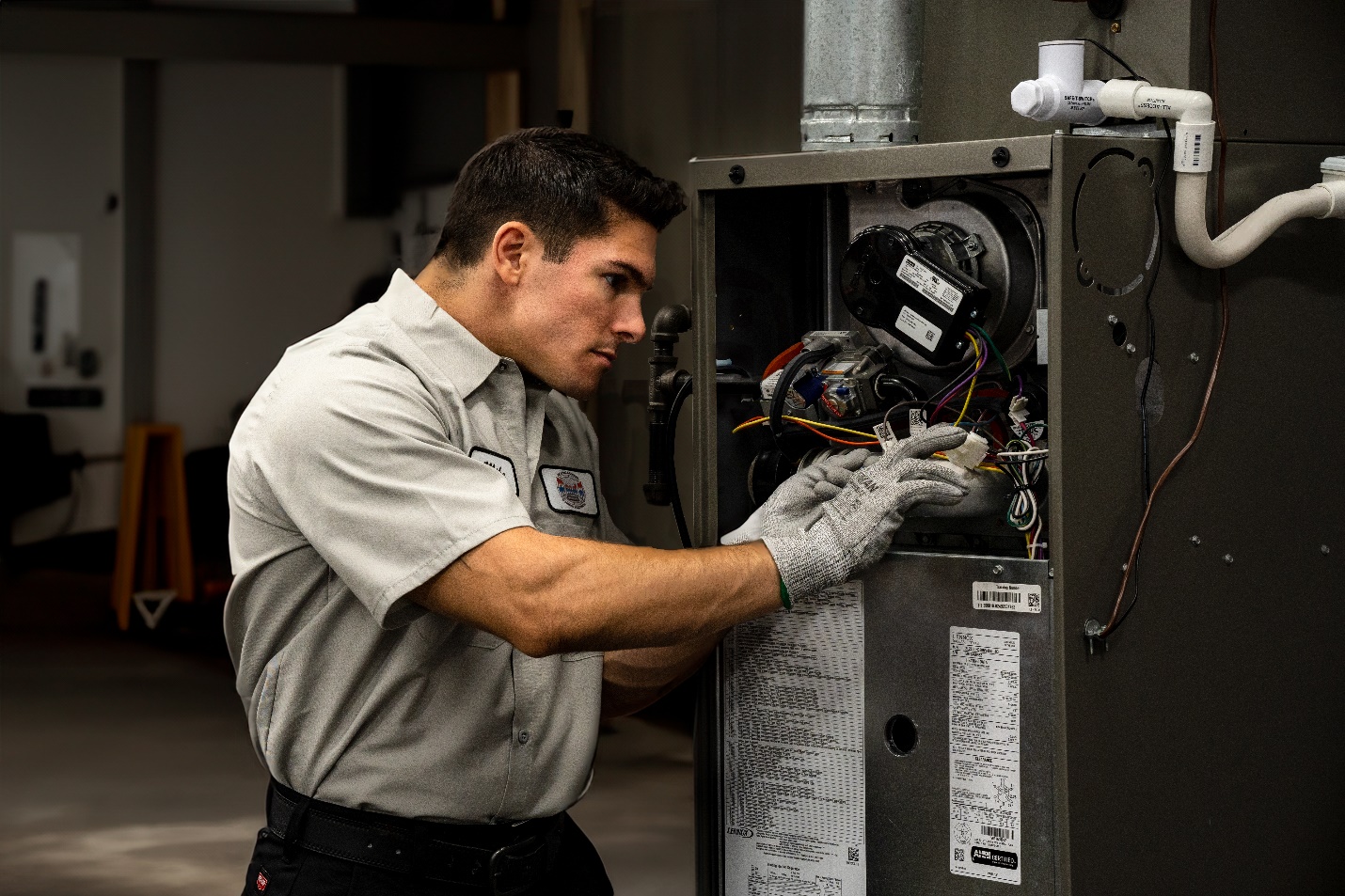Your heater is a lifeline during the cold winter months, so nothing could be more frustrating than coming home to a thermostat set to a comfortable temperature, yet a chill in the air. If you find your heater is not working, it can leave you confused and worried.
If your heater isn’t working, but your thermostat is, there could be many reasons. Some of these are simple fixes you can do yourself, but some of the bigger problems may require a qualified HVAC technician. Here’s everything you need to know from the experts at M&M Heating, Cooling, Plumbing, and Electrical.
How Does a Heating System Work?
It’s important to understand the basics of how your heating system works to address the possible causes of your broken heater without a broken thermostat.
For central heating systems, which are common in larger homes and buildings, usually have a boiler or furnace, a thermostat, and a system of ducts or pipes that distribute heated air or water throughout the building. The thermostat is responsible for regulating the temperature in the house by sending signals to the heating source to turn on or off, based on the desired temperature.
With individual room heaters, such as baseboard electric heaters, wall heaters, or space heaters, they may each have their own thermostats. This allows independent temperature control in different areas of your home. Like central heat, these heaters rely on the thermostat setting to power on and off.
Common Causes of a Heater Not Working with a Functional Thermostat
There are several common reasons why your heater may not be working, even though your thermostat is:
Furnace or Boiler Problems
- Lack of maintenance: One of the main reasons for heating issues is a lack of maintenance. If your furnace or boiler hasn’t been serviced regularly, it may lead to problems like clogged filters, dirty burners, or failing components. Regular maintenance is essential to keep your heating system in good working condition.
- Pilot light issues: For gas furnaces, a common problem is the pilot light going out. A malfunctioning pilot light can prevent the furnace from igniting and producing heat. In such cases, relighting the pilot light or addressing issues with the thermocouple may solve the issue.
- Faulty ignition system: In modern gas furnaces, an electronic ignition system is used instead of a pilot light. If this system fails, your furnace won’t start. A professional technician can diagnose and repair ignition system issues.
- Thermocouple problems: The thermocouple is a safety device that senses the pilot flame’s presence and prevents gas from flowing if the flame is out. If the thermocouple is malfunctioning or damaged, it can prevent the furnace from working properly, no matter what the thermostat says.
- Blower motor or fan problems: If the furnace’s blower motor or fan is not working correctly, warm air won’t be distributed through your home. This can make it seem like the heater is not working, even though it is. It’s actually the distribution of heat that’s malfunctioning.
- Clogged air filters: Dirty or clogged air filters can restrict airflow, making it difficult for your heating system to warm your home efficiently. This can result in the thermostat reaching the desired temperature, but the air isn’t being effectively distributed.
Ductwork Issues
- Leaky ducts: In central heating systems, the ductwork plays a crucial role in delivering heated air to different parts of your home. If there are leaks or disconnected ducts, the warm air may be escaping before reaching the rooms, leaving you with a cold house.
- Obstructed ducts: Sometimes, ducts can become obstructed by debris, such as dust or even pests. This can hinder the flow of warm air and result in uneven heating throughout your home.
- Poor insulation: Inadequate insulation in your home can cause heat loss. Even if your heater is working correctly, the heat can escape through poorly insulated walls, windows, and doors. This can make it seem like your heater is not functioning, though it’s just struggling to maintain the appropriate temperature because of heat loss.
Thermostat-Related Issues
- Incorrect thermostat settings: You must set your thermostat to the desired temperature and select heating mode to get your house to your comfort level. If the thermostat is accidentally set to a lower temperature or cooling mode, it may prevent the heater from turning on.
- Thermostat location: The location of your thermostat can affect its accuracy. If it’s placed near drafts, in direct sunlight, or near heat sources, it may not accurately represent the temperature in your home. As a result, the thermostat may turn off the heater prematurely.
- Thermostat malfunction: Thermostats can experience malfunctions, even if the temperature setting is correct. If the internal components are not working properly, it may not send the right signals to your heater.
Electrical and Power Issues
- Circuit breaker trips: Sometimes, the issue can arise from a tripped circuit breaker. If the circuit that supplies power to your heater is interrupted, it can’t work properly. Check your circuit breaker panel for any tripped breakers and reset them if necessary.
- Faulty wiring: Wiring problems in your heating system can lead to a breakdown in communication between the thermostat and the heater. Faulty wiring can prevent the thermostat from sending signals to the heating system.
- Power outages: If you experienced a recent power outage, your heating system may need to be reset. Some systems require manual intervention to restart after a power interruption.
Fuel Supply Issues
- Fuel shortage: If your heating system relies on a fuel source like natural gas, heating oil, or propane, a shortage of fuel can cause your heater to stop working. Check your fuel levels.
- Gas line issues: For gas heaters, issues with the gas supply line can prevent the furnace from igniting. Gas line problems should be addressed by a professional technician.
Environmental Factors
- Extremely cold weather: In extremely cold conditions, heating systems may struggle to keep up with the demand for warmth. While the thermostat may be set at a comfortable temperature, the heater might not be able to reach it.
- Blocked vents or registers: If your vents or registers are blocked by furniture or other items, it can obstruct the airflow and prevent the heater from warming the room properly.
- Blocked air intake or exhaust: For high-efficiency furnaces, there are air intake and exhaust pipes that need to be clear for the system to function. If these pipes are blocked by debris, the furnace may shut down as a safety measure.
- Frozen pipes: In extremely cold conditions, water pipes connected to heating systems can freeze, leading to system shutdown. If this happens, you’ll need to thaw the frozen pipes and take steps to prevent future freezing.
How to Troubleshoot Your Heater
Here are some troubleshooting steps you can take to identify and resolve the issue:
1. Check the thermostat: Start by confirming that your thermostat is set to the desired temperature and heating mode. Make sure there are no accidental setting changes.
2. Replace the batteries: If your thermostat runs on batteries, check that they’re not low or dead. Replace them if needed.
3. Inspect air filters: If your heating system has air filters, check them for dirt and clogs. Clean or replace them to ensure proper airflow.
4. Examine the circuit breaker: Check your electrical panel for any tripped circuit breakers related to your heating system. Reset if necessary.
5. Verify fuel supply: If your heating system relies on fuel, ensure that you have an adequate supply.
6. Remove obstruction: Ensure that there are no obstructions in front of the vents or registers. Clear any clutter that can hinder airflow.
7. Test the thermostat: You can see if the thermostat is sending signals correctly by setting the temperature a few degrees higher than the current room temperature and listening for a click, which indicates that the thermostat is trying to get heat.
8. Rest your heating system: If all of the above factors aren’t the cause of the problem, try resetting your heating system. You can turn off the power, wait a few minutes, and then turn it back on.
When to Call a Professional HVAC Technician
If you’ve gone through the basic troubleshooting and your heater is not working, it could be a more complex problem like a faulty ignition system or gas line issue. It’s important to seek professional help for heater repair. Here’s why:
- If you’re not experienced with boiler or furnace repair, it can be a dangerous job to work on them yourself. Certified HVAC technicians have the training and tools to take care of the problem quickly and safely.
- For gas furnaces, any issues with the gas supply, the pilot light, or the ignition system should be addressed by a professional because of serious safety hazards.
- If you suspect electrical issues, such as malfunctioning electrical components or faulty wiring, it’s crucial to contact an HVAC technician for proper diagnosis and repair.
- Problems with your ductwork and insulation should be addressed by an HVAC technician who can evaluate your system and recommend necessary repairs or upgrades.
Get Help for Your Heater
A broken heater with a functional thermostat is a frustrating problem to have, especially in the dead of winter. At M&M Heating, Cooling, Plumbing, and Electrical, we’re here to help for everything from a broken thermostat to clogged drains to appliance upgrades to save water.
If you need heater repair or heating service, contact us today to schedule your appointment!




















